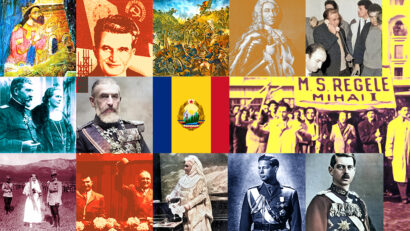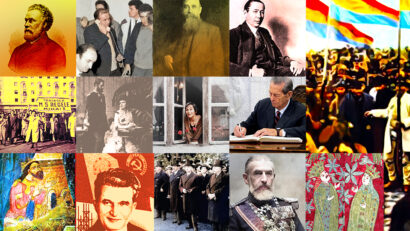The Teutonic Knights on Romanian Territories
Medieval warrior monastic orders were set up to spread Christianity, but also to defend or take back territory in the face of Muslim conquest

Steliu Lambru, 24.02.2020, 14:33
Medieval warrior monastic orders were set up to spread Christianity, but also to defend or take back territory in the face of Muslim conquest. The best known such monastic orders were the Teutonic Knights, the Templars, and the Hospitalers. The Teutonic Knights arrived in the Carpathian basin as part of a Western expansion strategy for the eastern territories. Hungarian king Andrew II was attempting to fortify the Carpathian frontier, and to spread Catholic teachings to the north and the east. With austerity and a martial spirit, they converted to Catholicism migratory pagan peoples and members of Christian Orthodox communities in the attempt to rebuild the unity of the Christian church. The austerity of their spirit can be seen in their heraldic symbols: the white shield, the color of religious purity, with a black cross, symbol of war in defense of the faith. In 1211, the knights arrived in Transylvania and settled there, forming a mark for defense in the Carpathian bend and to the southeast of it, in what is now the county of Vrancea.
Academician Ioan Aurel Pop, professor of medieval history with the Babes-Bolyai University in Cluj, told us about the important contribution of the Teutonic knights to the local culture, long lasting in spite of their short presence:
“They built quite a lot, and testimony that we now have shows that they built at least one very important fortification, Cruceburg. They also built fortifications called back then ultra montes nivium, Latin for building over snowy mountains. They expanded more than allowed by Hungarian king Andrew II, coming into conflict with his policy, which sought to use the knights in pursuit of local policies, rather than wider aims. The Holy See sought to create a state under papal authority, a sort of bridgehead. We have scarce data about the Teutonic Knights, because there were no local chancelleries, since Transylvania was just beginning to function as a voivodate within the Kingdom of Hungary. At the same time, south and east of the Carpathians, territories that were within the Knights bailiwick, had no centralized states, therefore sources are few and far between, they are generally foreign sources, many of them written at a distance from the place where everything was happening.”
Papal documents from the time that the knights settled in Barsa Country show that at the time of their arrival the area was inhabited by a mixed population of Romanians, Slavs, and Pechenegs. The Teutonic Knights, as a militant missionary order, had to sustain themselves, and therefore they secured rights to exploit gold and silver mines in Transylvania. They were adept builders, and built all across Barsa Country many forts of wood and mud, such as Feldioara, the Black Fortress, and the Fortress of the Cross. They bolstered the local population of Romanians and Pechenegs with German peasants and craftsmen, which built up the settlements of Feldioara, Brasov, Codlea, Rasnov, and Prejmer. However, the Teutonic Knights soon came into competition with the Hungarian Crown, as they had papal support. After winning a few battles against the Cumans in southeast Transylvania, they occupied the latters territories, placing them under papal authority, instead of that of the Hungarian throne. As a result, in 1225 the king of Hungary ousted the Teutonic Order from Barsa Country, and they headed upwards, to what is now northeastern Poland.
Belonging to such an elite was not easy. We asked Ioan Aurel Pop to tell us what kind of conditions one had to meet as a member of the order:
“You had to be a monk, which meant accepting the conditions of monastic living, with chastity and prayer, and at the same time you had to be a warrior. Military monastic orders had as their vocation fighting for the faith sword in hand, spreading it in battle. Most members were noblemens sons, members of an elite that put themselves in the service of Christianity, serving these higher ideals which at that time were among the highest moral and religious aspirations, tied to expanding the reach of Christianity. Medieval man could not conceive of a life outside the Church and the faith, having an unbridled dedication to religious life. That is the reason why in the Middle Ages excommunication was fatal, it could dismantle an entire society. The people who dedicated their life to the Church were monks, but warrior monks had to have additional qualities, physical strength, determination, resolution, observing strictly a very special hierarchy.”
Monastic orders of the Middle Ages had an ethnic component as well, which Ioan Aurel Pop believes were at the root of future national identities, which was the case for the Teutonic Knights:
“There was a national component to the Teutonic Order, which was formed principally of Germanic people, while the Templar Order was made up mostly of French people. The conflict that sealed their fate is famous, the conflict with Philip the Fair of France. These orders had an ethnic element, which eventually became national, because gradually, as they went from the Middle Ages into the Renaissance, they put themselves in the service of the Holy Roman Empire, fighting against the Poles, who were also Catholic.”
After their departure from Transylvania, the Teutonic Knights crossed paths with Romanians once again. In 1410, Moldavian ruler Alexander the Good, sent an army corps to join the Polish-Lithuanian forces against the Knights in the Battle of Grunwald.





























